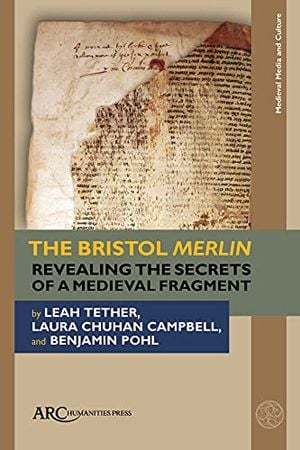Rediscovered Medieval Manuscript Offers New Twist on Arthurian Legend
The 13th-century pages, found by chance at a British library, show a different side of Merlin, the magician who advised Camelot’s king
:focal(1431x1050:1432x1051)/https://tf-cmsv2-smithsonianmag-media.s3.amazonaws.com/filer_public/04/eb/04ebe56a-a01c-4f86-816e-71ef5911d67a/bristol-manuscript-fra-1.jpg)
Thirteenth-century manuscript fragments discovered by chance at a library in Bristol, England, have revealed an alternative version of the story of Merlin, the famed wizard of Arthurian legend. A team of scholars translated the writings, known as the Bristol Merlin, from Old French to English and traced the pages’ medieval origins, reports Alison Flood for the Guardian.
The manuscript is part of a group of texts called the Vulgate Cycle, or the Lancelot-Grail Cycle. Using handwriting analysis, the researchers determined that someone in northern or northeastern France wrote the text between 1250 and 1275. That means it was committed to parchment shortly after the Vulgate Cycle was first composed, between 1220 and 1225.
“The medieval Arthurian legends were a bit like the Marvel Universe, in that they constituted a coherent fictional world that had certain rules and a set of well-known characters who appeared and interacted with each other in multiple different stories,” Laura Chuhan Campbell, a medieval language scholar at Durham University, tells Gizmodo’s Isaac Schultz. “This fragment comes from the second volume, which documents the rise of Merlin as Arthur’s advisor, and Arthur’s turbulent early years as king.”
King Arthur first appeared in a history of Britain written in 829 or 830, notes the British Library. That text describes him as a warlord or Christian soldier. Later accounts from the 12th century added new elements to the legend, such as Merlin’s mentorship of Arthur. English writer Thomas Malory compiled one of the best-known collections of the stories, Le Morte d’Arthur, in the 15th century.
/https://tf-cmsv2-smithsonianmag-media.s3.amazonaws.com/filer_public/df/76/df762d1a-b0d7-4748-9494-18cf5edd4618/merlin-1.jpg)
Michael Richardson, a special collections librarian at the University of Bristol, found the parchment pieces glued into a 15th-century book in 2019, reports Sarah Durn for Atlas Obscura. Since then, Campbell and colleagues Leah Tether and Benjamin Pohl, both medieval historians at Bristol, have concluded that the pages made their way to England about 80 years after they were written.
“We know it was in England by that point [because] someone has written ‘my god’ in the margins in English,” Campbell tells Atlas Obscura. “From the handwriting, we’ve dated that to the early 14th century.”
By 1520, the pages had ended up in a scrap pile at a British bookshop, where they were used as binding materials for a French philosophy text. That book found its way to the Bristol public library sometime after the collection’s establishment in 1613. As the scholars explain in a statement, the book’s “likely route to Bristol” was Archbishop of York Tobias Matthew, who co-founded the library and collected many books in Oxford. Matthew left his collection to the library after his death in 1628.
The text probably remained at the library until Richardson discovered the pages in 2019. Now, the scholars have published the translation, as well as their study of the manuscript fragments, in a book titled The Bristol Merlin: Revealing the Secrets of a Medieval Fragment.
The Bristol Merlin: Revealing the Secrets of a Medieval Fragment
The discovery of seven manuscript fragments of the Old French Suite Vulgate du Merlin in a set of early printed books in the Bristol Central Library hit global headlines in 2019.
The team found that the account differed from other versions of the story in several key ways. A sexual encounter between Merlin and Viviane, also known as the Lady of the Lake, is “slightly toned-down,” Tether tells the Guardian.
She adds:
In most manuscripts of the better known [version], Viviane casts a spell whereby three names are written on her groin that prevent Merlin from sleeping with her. In several manuscripts of the lesser-known version, these names are written on a ring instead. In our fragments, this is taken one step further: the names are written on a ring, but they also prevent anyone speaking to her. So the Bristol Merlin gets rid of unchaste connotations by removing reference to both Viviane’s groin and the idea of Merlin sleeping with her.
Based on an analysis of the handwriting, the fragments of writing appear to have been penned by two people. That could mean an apprentice was working with an experienced scholar to record the legend. Using a spectroscopic technique called Raman scattering, the team reconstructed parts of the text that had worn away.
Altogether, about 200 versions of the Vulgate Cycle are known to exist, with different scribes revising the text either accidentally or purposefully.
“With medieval texts there was no such thing as copyright,” Campbell tells Atlas Obscura. “So, if you were a scribe copying a manuscript, there was nothing to stop you from just changing things a bit.”
Merlin’s image has changed dramatically over the centuries. In more modern versions of the King Arthur legends, he is a wise advisor to the king. In the earliest iterations of the story, however, Campbell says he was a “morally dubious” magical seer or even a “creepy little boy [whose] father is a devil.”
A Note to our Readers
Smithsonian magazine participates in affiliate link advertising programs. If you purchase an item through these links, we receive a commission.
/https://tf-cmsv2-smithsonianmag-media.s3.amazonaws.com/accounts/headshot/Livia_lg_thumbnail.png)

/https://tf-cmsv2-smithsonianmag-media.s3.amazonaws.com/accounts/headshot/Livia_lg_thumbnail.png)